JANUARY 24, 2024: The next morning, our second day in LA, we visited with my cousin, who lives in a canyon road in the heart of LA. This was a beautiful area, like being in a nature reserve, smack in the middle of the city.
After a wonderful visit, we headed to the current location of Canter’s Deli in Fairfax. It’s original location was in Boyle Heights on Brooklyn Avenue (the place we had visited yesterday). We were not going to the deli to eat (not kosher), but rather to see the parking lot. In the parking lot, along the outside wall of the deli building, is a mural depicting the history of the Jewish community in Los Angeles. It was painted by Los Angeles muralist Art Mortime in 1985 and has seven panels, depicting scenes in chronological order from left to right.
We were wondering in what condition the paintings would be in, since when looking up information about the mural, there were several news stories about the defacing of the mural in November 2023 with antisemitic graffiti. Now, three months later, we gladly saw no signs of the defacing.
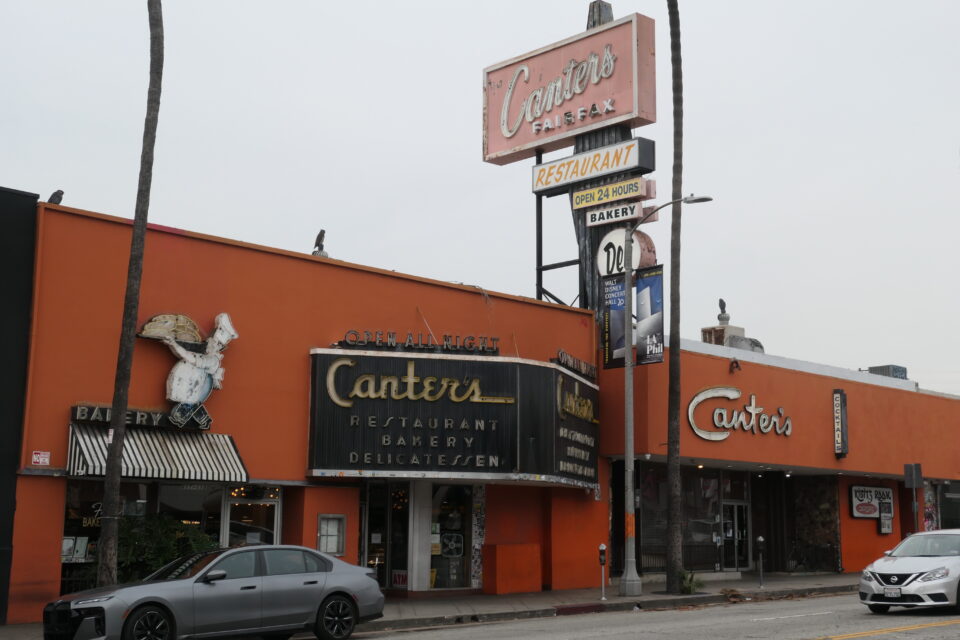
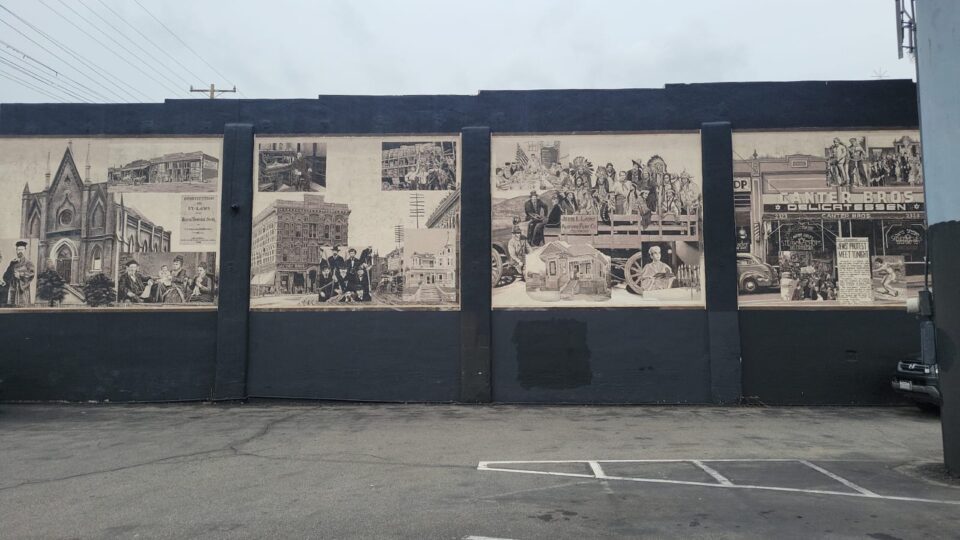
Some interesting anecdotes about Jewish LA history are shown in the mural. On the left-most panel, showing the beginning of the Jewish community in the 1860’s, there is a painting of the Newmark family. Some historians say that without the Newmarks, there would be no Jewish LA. When the first Jews arrived with the Gold Rush, they were all young, single males. It was only after the Newmarks arrived with four daughters, who then married four successful Jewish merchants and created a new generation, that the continuity of the community was assured.
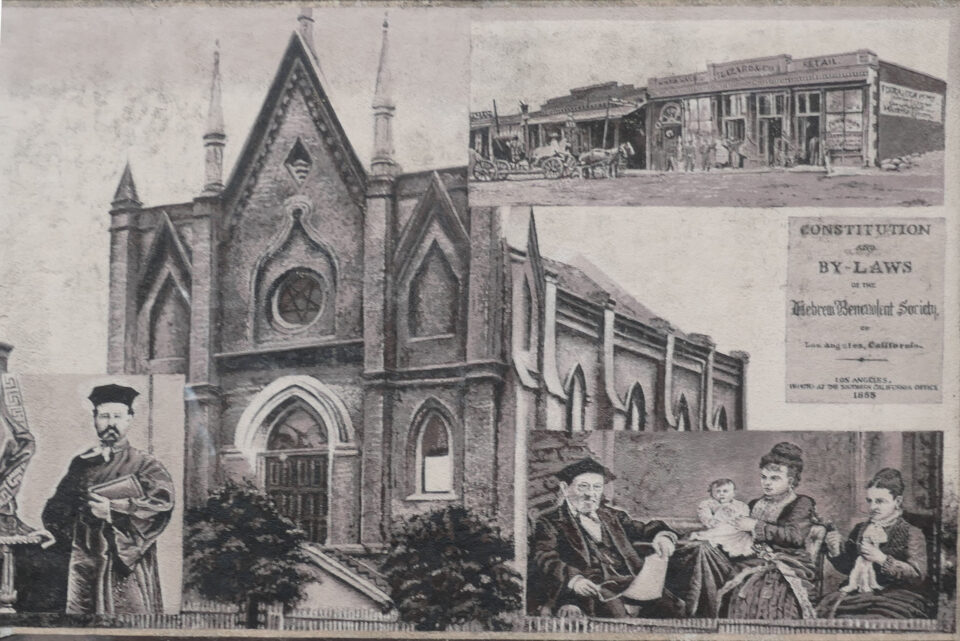
Related to what we saw yesterday, the building in this first panel is the original Wilshire Boulevard Temple, the first synagogue in Los Angeles. There is also a depiction of the booklet with the Constitution and By-Laws of the Hebrew Benevolent Society, mentioned in yesterday’s blog.
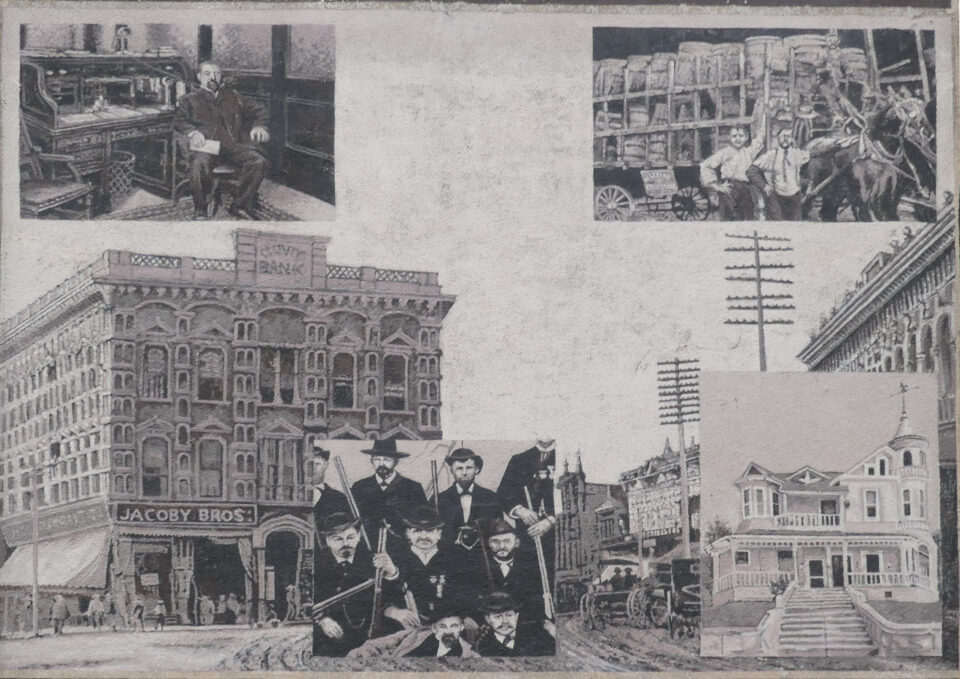
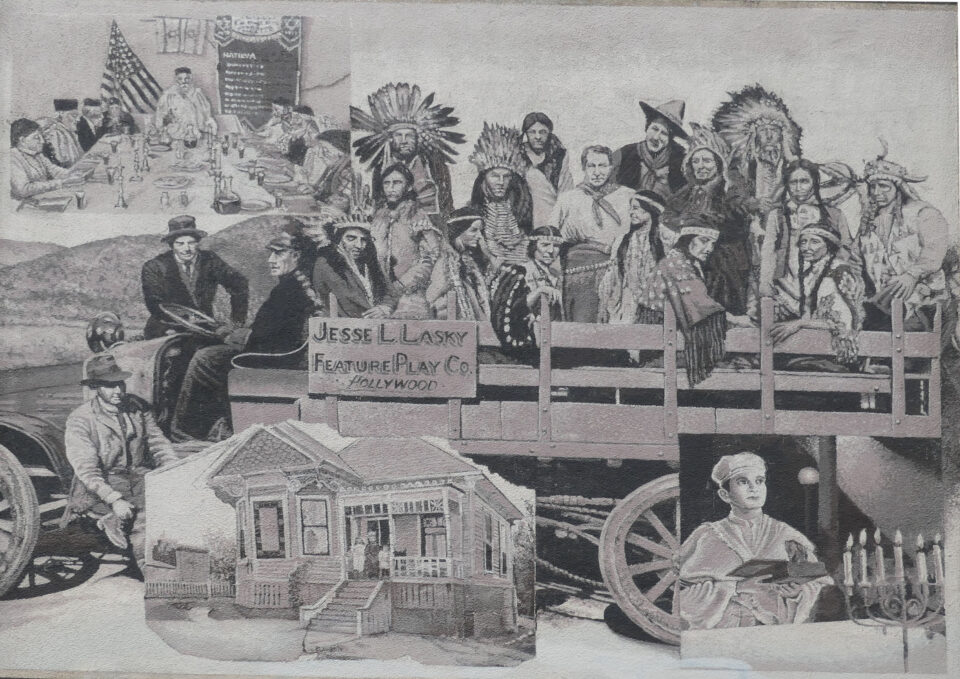
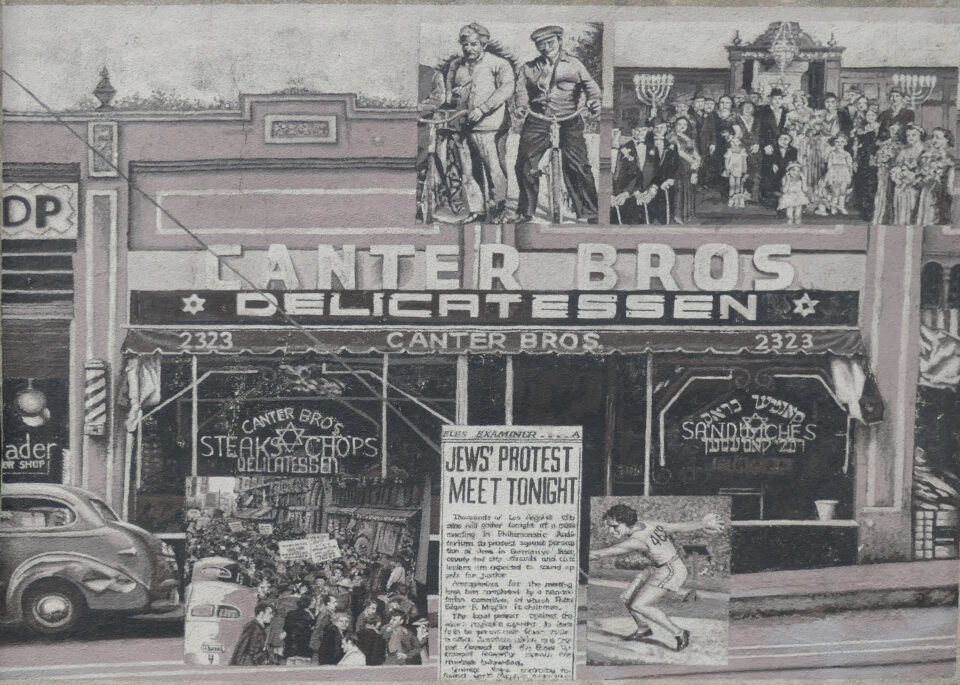
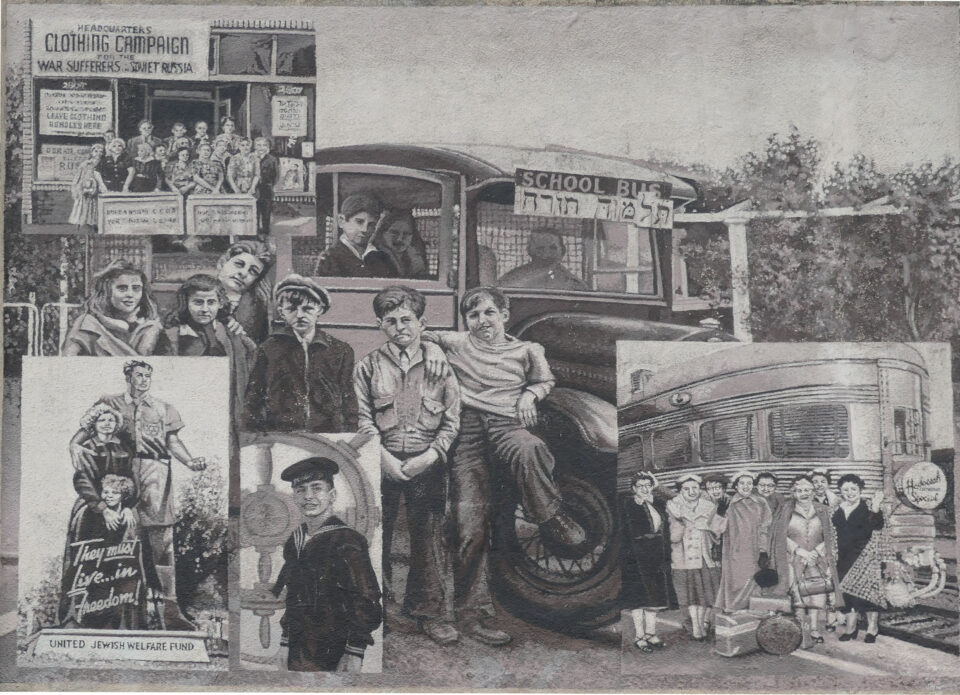
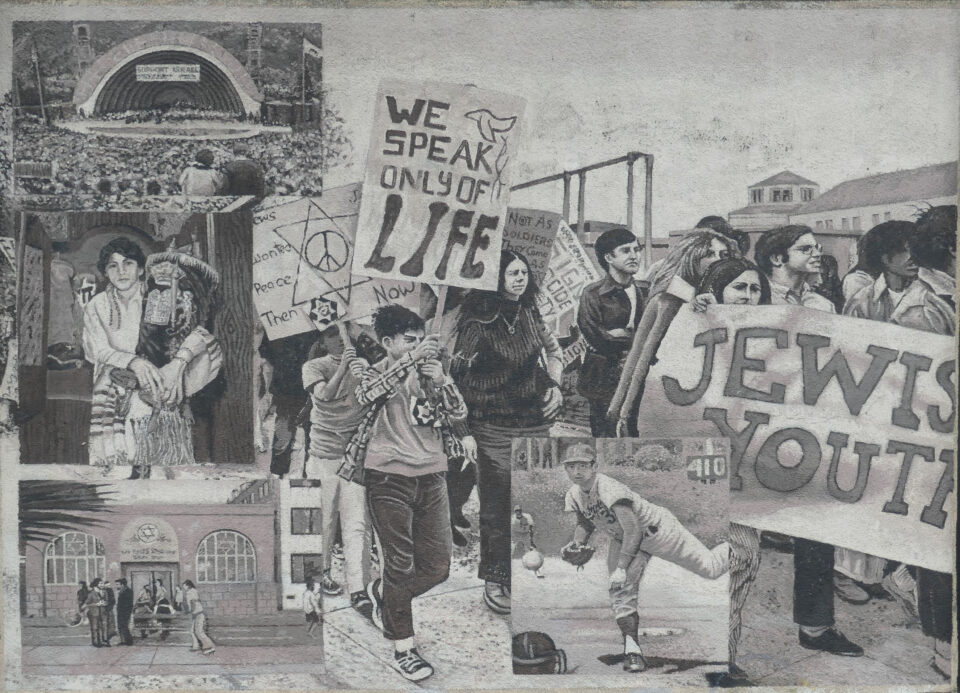
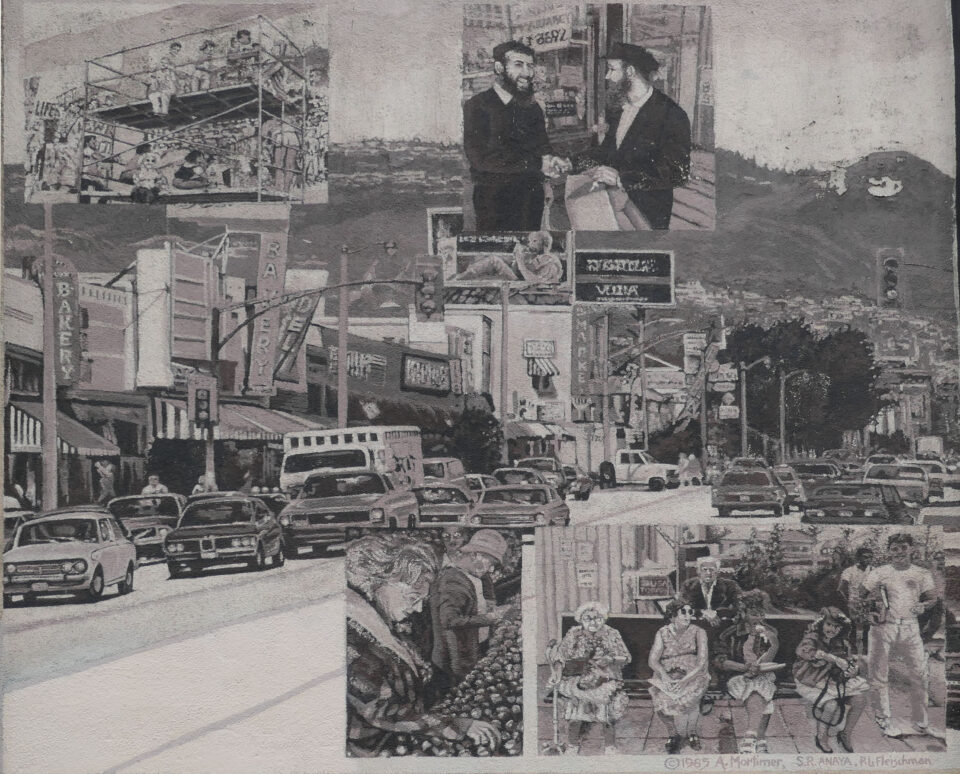
Other highlights include in panel 3, the home of one of the first Jewish families to live in Boyle Heights and Al Jolson as a rabbi in The Jazz Singer. Panel 4 depicts Canter’s original location also in Boyle Heights and Lillian Copeland, a Jewish gold medalist at the 1932 Summer Olympics held in Los Angeles. In the sixth panel, there is a picture of an event in the Hollywood Bowl to raise money to help Israel during the Six Day War. Sandy Koufax, Hall of Fame pitcher for the Los Angeles Dodgers is also there. On the last panel, depicting Fairfax in 1985, you can see scaffolding and workers painting this mural.
After seeing the mural, our next stop was The Milky Way – a kosher dairy restaurant founded by Steven Spielberg’s mother, Leah Adler. She opened the place in 1977 with the vision to offer fine kosher food to the Jewish community at a time when such a thing did not exist in LA. It soon became apparent that the main attraction wasn’t just the food but was Leah herself. She had the ability to make every guest in the restaurant feel as if they were most important, as though they were invited to eat in her own dining room. Leah died in 2017, at the age of 97, but the restaurant lives on.
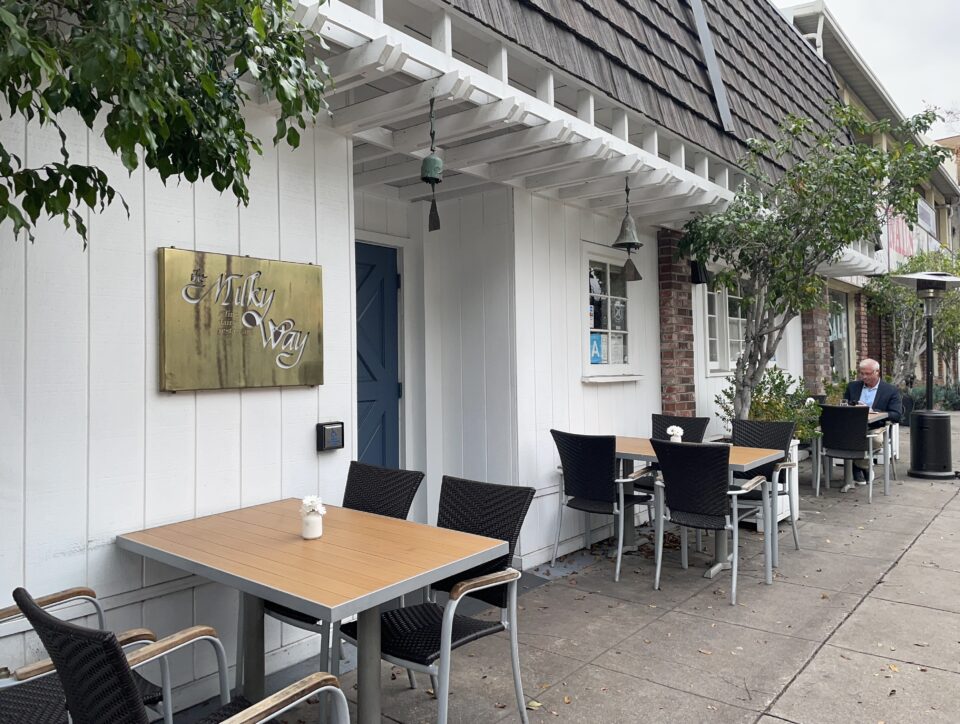
Her desire to make the restaurant feel like home was apparent by the many family photographs decorating the walls. There are photos of Leah, her husbands, of Steven and his two sisters spanning many years. A long hallway in the restaurant is full of movie posters, almost all of which were directed by her son.
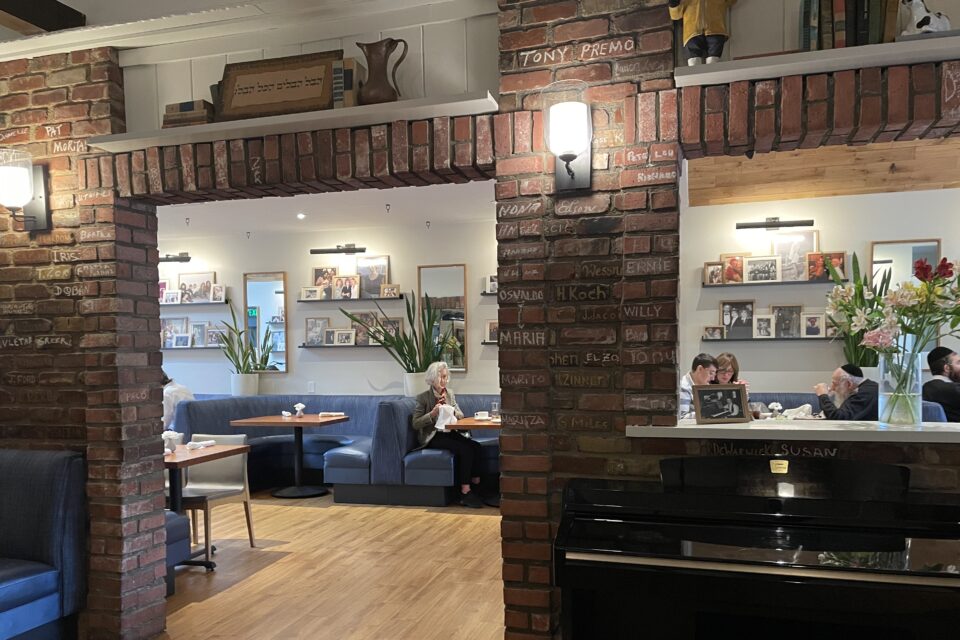

Yesterday, when we came to the Wilshire Boulevard Temple and could not get in, Mark sent them an email saying that we are documenting Jewish Heritage sites and will be in LA only until the rest of today. Knowing that all the tickets on-line for the month were already sold, we were not very hopeful. However, while eating our lunch, we received a text message that we could have a tour of the synagogue today at 14:30. We quickly finished our food and went to meet Nan, our personal guide.
The first thing we saw is that the Wilshire Boulevard Temple is much more than just a place of worship. Aside from the synagogue, the grounds include a pre-school, an elementary school, a multi-story parking garage, a rooftop sports complex, and the Karsh Family Social Service Center. The center offers free social services to the greater community, including a food bank (which we saw people lined up for yesterday), an eye clinic, dental care, and a legal aid center, as well as citizenship classes and literacy programs. Nan pointed out that the Social Service Center demonstrates the Temple’s longstanding serious commitment to tikun olam. They will soon be dedicating another building that will serve as an event hall, whose proceeds will be used to further all that they do.
In addition to these premises, the Temple has two more campuses in LA, each with their own synagogue and educational facilities.
The Wilshire Boulevard Temple congregation is the oldest in LA, founded in 1862 as Congregation B’nai B’rith. The synagogue in this location was completed in 1929, and a few years later the congregation’s name changed to its current name. The building of this synagogue was the vision of Rabbi Edgar F. Magnin, who served as its rabbi for almost 70 years, from 1915 and until his death in 1984. He wanted a building that was awe-inspiring, like the cathedrals in Europe, but also did not make you feel small, that made you feel welcome with its warmth. Walking into the main sanctuary, standing under the huge domed ceiling, you understand that he succeeded in his mission.
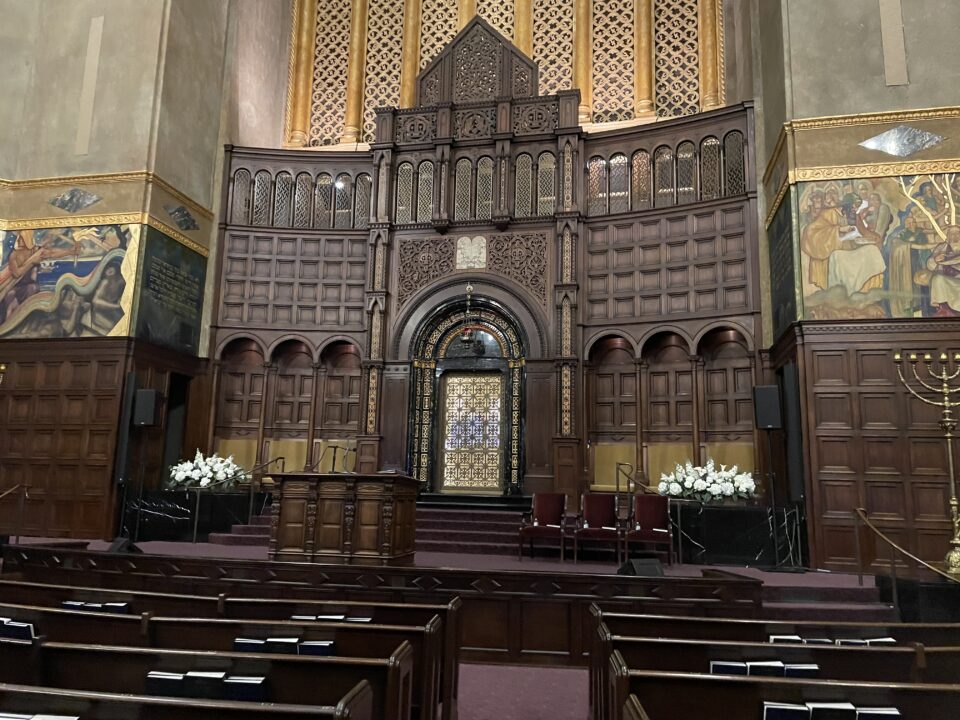
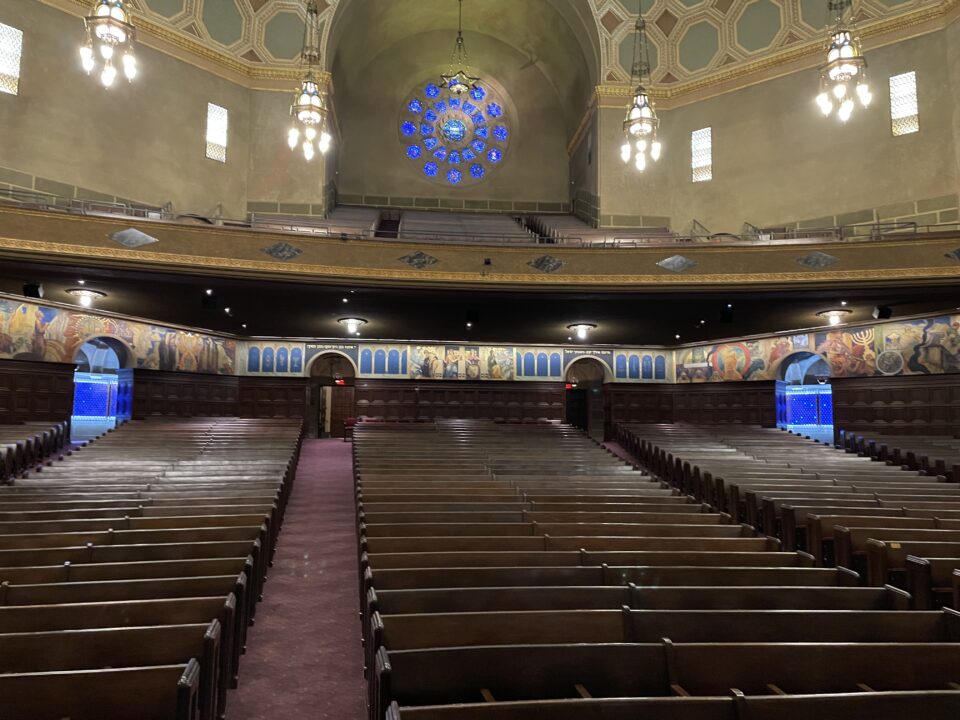
All around the main sanctuary is a mural. It starts on the right of the bimah with a scene from Geneses (בראשית), wraps around the sanctuary and depicts 3000 years of Jewish History. The last scene, on the left side of the bimah, shows the Jews coming to America. The mural was created by the renowned muralist Hugo Ballin and completed in 1929. This pre-dates two major events in Jewish History – the Holocaust, and the creation of the state of Israel – and they are not included in the mural.

Rabbi Magnin used the pulpit, his radio program, and newspaper columns to fight against anti-Semitism and to help Jews be accepted in Los Angeles’ strongly Protestant society. Under his reign, Wilshire Boulevard Temple was for several decades the largest Jewish congregation in the western US. He was known as the “rabbi of the stars”, because of his close connections to those in the film industry. The Wilshire Boulevard Temple was the synagogue where Hollywood celebrities got married, had funerals, or celebrated their children’s bar mitzvahs. The Hollywood connection is also felt in the sanctuary design. The mural was donated by three of the five Warner brothers, in memory of the two brothers that passed away. Universal co-founder Carl Laemmle donated the bronze Havdalah spice-box inspired chandeliers, Louis B. Mayer of MGM donated the east and west stained-glass windows, among others.
One of the things that Rabbi Magnin did to foster togetherness in the congregation was to abolish the use of kippot (head coverings) and tallitot (prayer shawls.) He thought that if you recognized someone that came from the same area in Europe as you, a landsman, by the style of their tallit, you would naturally go sit with them. This would have prevented the intermingling of everyone into one community. Thus no kippot and tallitot in the sanctuary. I forgot to ask if this is still held today.
We learned from Nan that about 15 years ago, they did a huge renovation and restoration. Renovation is when they built something new, and restoration is when they repaired something old. Part of the renovation was to add the school buildings and the parking garage. In the main sanctuary, they added air conditioning, better lighting and sound systems and made the bimah handicap accessible. Previously the building had been cooled with huge blocks of ice under the main hall and large fans pushed the cold air through vents on the floor. Aside from adding these modern conveniences, everything else in the sanctuary was restored to its original glory.
Nan pointed out that it is important to them that people should know what was added during the renovation and what was original and restored. To differentiate, anything that was added, was created with a specific pattern – for example, the grills on the air conditioning vents, have the renovated design pattern. Anything with this pattern, is new.
Once we left the sanctuary, Nan showed us a display recently created outlining the important events in the history of the synagogue and the significant contributions temple members made to the health, welfare, education and cultural life of the city.
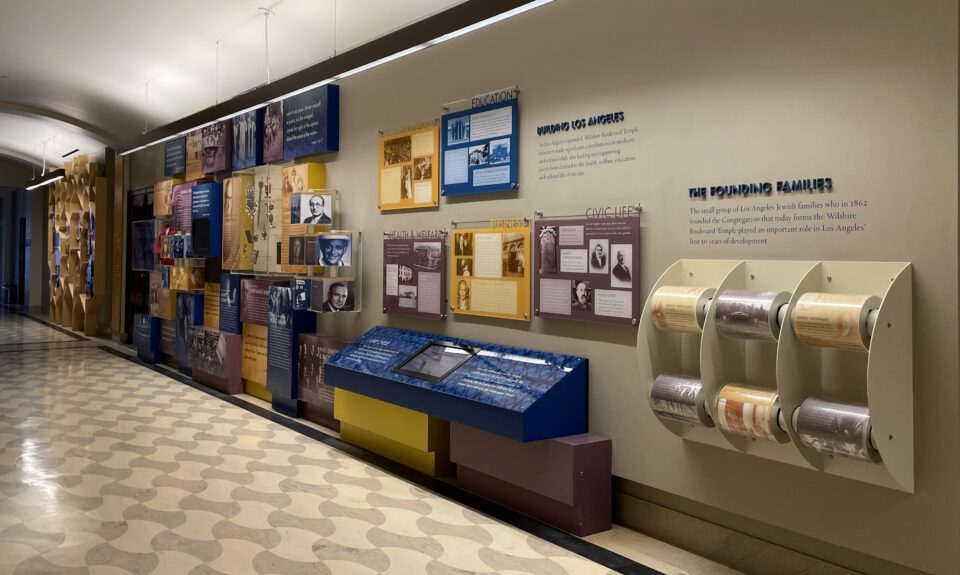
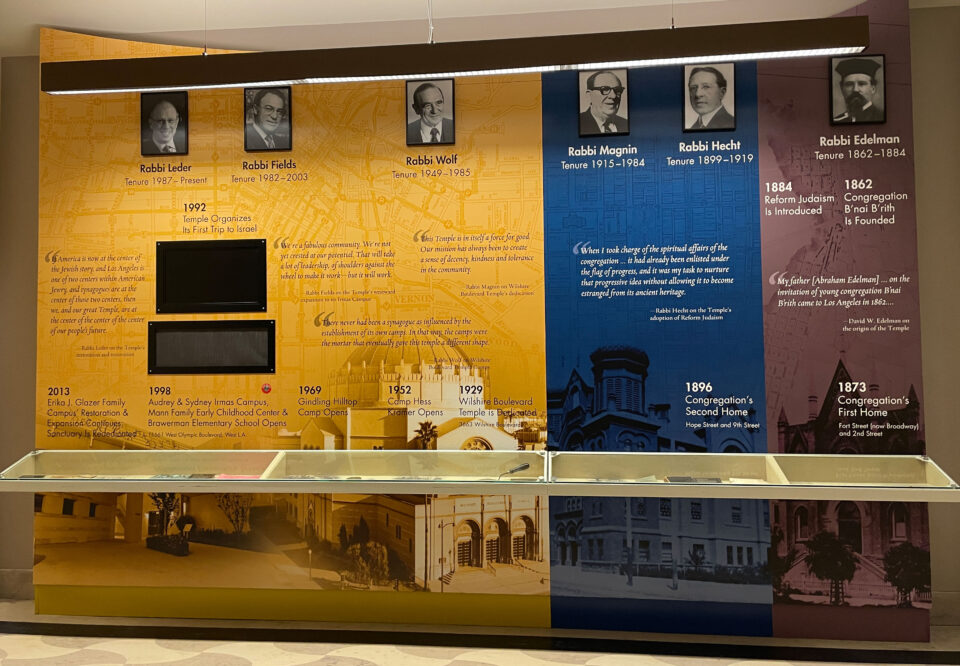
On one of the panel, the current rabbi, Rabbi Leder, is quoted as saying “America is now at the center of the Jewish story, and Los Angeles is one of the two centers of American Jewry, and synagogues are at the center of those two centers, then we, and our great Temple, are at the center of the center of the center of our people’s future.” A good summary of the prominence of this place.
After our interesting visit, we went to have dinner with Mark’s cousin. What should have been a 30-minute drive, turned into a 90-minute crawl. You cannot write about LA without mentioning the traffic. Traffic jams seem to happen at all hours, every day. You cannot escape it. Much of our time there was spent looking at the long line of tail lights ahead of us.
In spite of the traffic, we would like to return. Not only for family, but because during our two days in LA, we saw mostly off-the-beaten-path Jewish heritage sites, skipping the better known ones. Three places we still want to visit are the Holocaust Museum LA , the Museum of Tolerance (including the Simon Wiesenthal Center) and the Skirball Cultural Center. And of course, there are more off-the-beaten-path places to explore as well. Always leave something for next time.
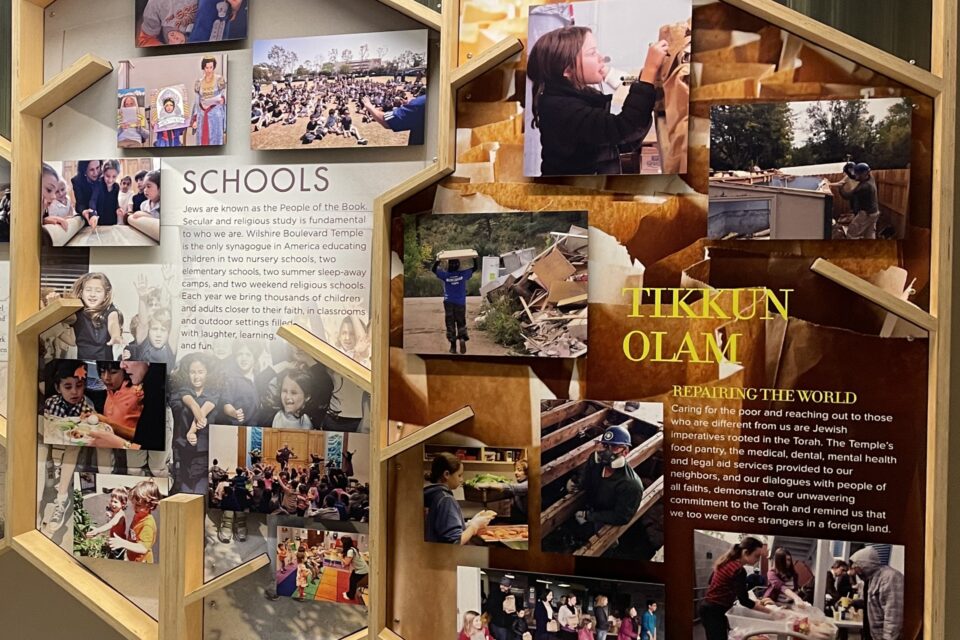
Fascinating! I didnt know that Speilberg directed West Side Story!! I like the excuse no tallit so we can all sit together! Today everyone has rainbow talisis and they still manage to sit all together…
very nice!